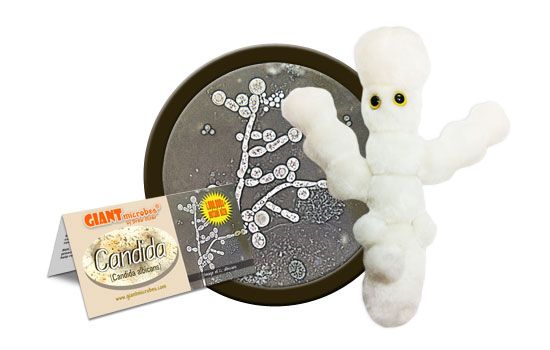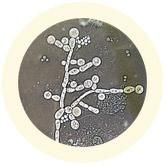Candida fungus
Out of Stock
Product Details
Additional Information
| Sizes | Giantmicrobes are based on actual microbes, cells, organisms and other critters, only 1,000,000 times actual size! Gigantic (GG) 16-24" XL (XL) 10-15" Original (PD) 5-8" Keychain (KC) 2-4" with clip |
|---|---|
| Materials | Plush from all new materials. Stuffed with polyester fiber fill. Surface washable: sponge with water & soap, air dry. |
| Packaging | Each plush microbe includes a printed card with fun, educational and fascinating facts about the actual microbe or cell. |
| Safety | Every product meets or exceeds U.S. and European standards for safety. For ages 3 and up. |
All about Candida fungus
FACTS: Candida is a common infectious fungus that usually live in harmony with human beings. Strains such as C. albicans live in over 80% of the population. It is a stolid member of the community of microorganisms normally found on the skin and in the mucous membranes and gastrointestinal tract. Another strain called C. auris is tenacious and sometimes deadly. It is a new example of one of the world's most intractable health threats: the rise of drug-resistant infections.
C. auris is a superbug fungus along the likes of the infamous MRSA bacteria. This Candida strain is impervious to major antifungal medications. It preys on people with weakened immune systems, and since the year 2010 has been spreading around the globe. Candida made global headlines in 2019 as lethal infections are adding alarming dimensions to the dangers of overusing medications. Over 500 C. auris infections have been reported in the US, and outbreaks are on the rise in Europe, Australia, Latin America and Asia as well.
C. albicans is a more passive strain of the fungus. It can develop territorial ambitions and transform from a quiet unicellular organism into an aggressive multi-cellular filamentous form. The result is candidiasis, commonly manifested as oral thrush, inflamed skin (such as observed in diaper rashes or compromised fingernails), or a genital yeast infection.
C. albicans infections can be provoked by such factors as a compromised immune system (whether from illness or stress), dietary changes, medical treatments or even alterations in hygienic routines that disrupt the normal balance of microorganisms.
These infections exhibit a distinctive whitish color. (Indeed, the name Candida albicans redundantly means “white white,” as candida derives from the Roman custom of “candidates” for political office wearing white to demonstrate their purity, and albicans “to be whitish.”). Except in extreme cases, such as found in bloodstream-impacting systemic candidal disease, C. albicans infections are not dangerous and often self-resolve. Still, a variety of treatments from home remedies and topical creams to prescriptive medication are available which can expedite the process and help restore your corporeal community to a state of tranquility and purity.
Like many fungi in the world, Candida is not well known or talked about, but it can wreak havoc and should not be underestimated. The superbug version of Candida has been described as a creature from the black lagoon that bubbled up and now it's everywhere!
| Name | This microbe was given a name that describes its most characteristic visible symptom, white patches. Both the genus and species names are Latin root words that mean white. |
|---|
| Actual Size | About 5 micrometers, which is 2,000 times smaller than a single M&M! |
|---|
| Where It Lives | Candida albicans is the most common species of Candida yeast and the most common cause of candidiasis, an overgrowth of yeast. It’s an opportunistic pathogen commonly found all over the environment, which means it only causes disease when the conditions are favorable. It can cause serious problems for individuals who have impaired immune systems, like the elderly or AIDS patients. |
|---|
| Symptoms | Candidiasis can occur all over the body—skin, throat, genitals, and even the blood stream. Candidiasis of the throat, or thrush, causes white patches on the tongue, pain and swelling in the mouth, nausea, vomiting, and weight loss. Genital candidiasis, commonly known as a yeast infection, is very common in adult women. It causes itching, irritation, burning, redness, pain and swelling in the vagina. Candidemia, or candidiasis of the blood, occurs in people who have underlying severe illnesses. It results in fever and chills, and can spread to major organs like the heart and brain. |
|---|
| Cure | Antifungal drugs |
|---|
| History |
Yeast infections were first described by Australian physician, David Grubby, during his tenure at Hospital St. Louis in France. Outbreaks: As treatment with antibiotics became more and more common in the 1950’s, yeast infections became more common. |
|---|
| Fascinating Facts | Lactobacillus acidophilus has been shown to control the growth of Candida yeast. Perhaps a yogurt a day may keep the doctor away! |
|---|






